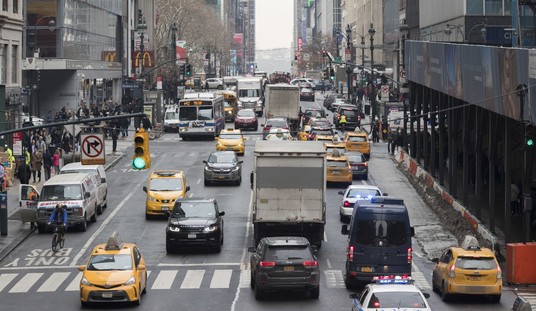The city is already locked down, with residents asked to remain at home as much as possible per one of Andrew Cuomo’s orders a week ago.
What Tom Bossert has in mind is a lock-in. No one in or out, except suppliers. Wall the city off until the spread of infection there is under control, whenever that is. Otherwise we’re risking the same problem that the Chinese had in Wuhan, moving too slowly to restrict the outflow of people and allowing them to seed outbreaks elsewhere.
There are nearly 31,000 confirmed cases of COVID-19 in New York State as of this afternoon, roughly half of all confirmed cases in the United States. New York City has nearly 18,000, a higher number than all but six countries on Earth. Bossert’s ready to go nuclear:
2/ Cordon sanitaire of NYC and messaging and planning aggressively for the other hot spots about to jump into exponential growth (like it appears New Orleans might).
— Thomas P. Bossert (@TomBossert) March 25, 2020
The feds may already be moving towards Bossert’s position. At yesterday’s briefing Deborah Birx recommended that anyone who’s left New York in the past 14 days should self-quarantine at their new location just in case they’ve brought COVID-19 with them. They’ve already seen outbreaks on Long Island which they believe were seeded by people traveling from the city. They must be considering the logical next step, especially with Trump complaining that the country needs to reopen for business soon.
Maybe that’ll be the next stage of denialism. “We closed the border with China so the problem is largely solved.” “We cordoned off New York City so the problem is largely solved.” A cordon sanitaire of NYC will help slow down the national spread, at least. But as Bossert says, new hot spots are already developing: The trends in Atlanta and New Orleans are ominous.
There are reasons to think NYC will end up being America’s hottest hot spot, if not its only hot spot. Why? Density, for starters.
New York is both the country’s most populous city and its most densely populated. Vinetz said both the city’s high density and the fact that it is densely populated across a large region could be exacerbating factors. Vinetz also cited the city’s status as a hub for global travel as a factor that could be contributing to the outbreak there…
Indeed, interviews with New York residents and officials suggested that both the New York lifestyle — replete with shoulder-to-shoulder public transportation, frequent dining out because of the limits of apartment living, and reliance on crowded city parks for daily recreation — as well as a certain stubbornness in curbing it may have contributed to New York’s high infection rate.
“We’re used to the city being our living room,” said Michael Hendrix, director of state and local policy at conservative think tank the Manhattan Institute. “We have smaller living quarters; we live with roommates. We make this choice because New York City has so much to offer.”
New York is also cooler this time of year than many southern states are, which *may* be conducive to contagion in this case. In some ways it’s a perfect petri dish. Oh, and it also has an imbecile for a mayor, per this tweet from as recently as March 2:
Since I’m encouraging New Yorkers to go on with your lives + get out on the town despite Coronavirus, I thought I would offer some suggestions. Here’s the first: thru Thurs 3/5 go see “The Traitor” @FilmLinc. If “The Wire” was a true story + set in Italy, it would be this film.
— Bill de Blasio (@BilldeBlasio) March 3, 2020
Lots of major metropolises in the Far East, like Hong Kong, also have high density but don’t have morons in charge, so they’ve been spared an outbreak of NYC’s scale.
New Yorkers do have a weapon against the virus, though. They’re using it, and there’s some evidence that it’s working:
The governor cited Tuesday projections that showed a doubling of hospitalization numbers is expected to occur every 4.7 days, compared to a Sunday projection that had shown every two days.
“Now, that is almost too good to be true,” he said, adding that the data indicates about 15 percent of people who test positive need hospitalization.
“This is everything,” he added. “Slowing the hospitalization rates coming into the hospitals are everything so the hospitals can deal with the rate of people coming in.”
Social distancing may be flattening the curve already. Checking the Kinsa “fever map,” I see that this trend (in Brooklyn) looks similar in the four other boroughs of New York City:

Because it takes several days for coronavirus infections to develop, it’ll take time for that trend to show up in a reduced patient load in city hospitals. People who were infected eight days ago, when the fever rate was still highly atypical, may only be starting to feel the effects now; it might be several more days still before they need hospital care. But if the Kinsa data is reflecting a drop in coronavirus transmission, presumably we’ll see hospital admissions start to slow down in, say, two weeks. Which is not to say they’ll slow to normal rates, of course. Even today, although the rate of fever has dropped, it’s still atypically high.
Here’s Scott Gottlieb talking about MASH units for the city.
“New York has another about 5 weeks to go for this … that they’re stretched right now is worrisome. What we need to be doing is developing mobile MASH units … moving all the resources we can into New York City,” @ScottGottliebMD on responding to the growing crisis in NY: pic.twitter.com/VfFwVG3rUL
— Squawk Box (@SquawkCNBC) March 25, 2020








Join the conversation as a VIP Member